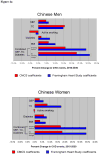Future cardiovascular disease in china: markov model and risk factor scenario projections from the coronary heart disease policy model-china
- PMID: 20442213
- PMCID: PMC2937540
- DOI: 10.1161/CIRCOUTCOMES.109.910711
Future cardiovascular disease in china: markov model and risk factor scenario projections from the coronary heart disease policy model-china
Abstract
Background: The relative effects of individual and combined risk factor trends on future cardiovascular disease in China have not been quantified in detail.
Methods and results: Future risk factor trends in China were projected based on prior trends. Cardiovascular disease (coronary heart disease and stroke) in adults ages 35 to 84 years was projected from 2010 to 2030 using the Coronary Heart Disease Policy Model-China, a Markov computer simulation model. With risk factor levels held constant, projected annual cardiovascular events increased by >50% between 2010 and 2030 based on population aging and growth alone. Projected trends in blood pressure, total cholesterol, diabetes (increases), and active smoking (decline) would increase annual cardiovascular disease events by an additional 23%, an increase of approximately 21.3 million cardiovascular events and 7.7 million cardiovascular deaths over 2010 to 2030. Aggressively reducing active smoking in Chinese men to 20% prevalence in 2020 and 10% prevalence in 2030 or reducing mean systolic blood pressure by 3.8 mm Hg in men and women would counteract adverse trends in other risk factors by preventing cardiovascular events and 2.9 to 5.7 million total deaths over 2 decades.
Conclusions: Aging and population growth will increase cardiovascular disease by more than a half over the coming 20 years, and projected unfavorable trends in blood pressure, total cholesterol, diabetes, and body mass index may accelerate the epidemic. National policy aimed at controlling blood pressure, smoking, and other risk factors would counteract the expected future cardiovascular disease epidemic in China.
Conflict of interest statement
Figures






Comment in
-
The impending cardiovascular pandemic in China.Circ Cardiovasc Qual Outcomes. 2010 May;3(3):226-7. doi: 10.1161/CIRCOUTCOMES.110.957183. Epub 2010 May 4. Circ Cardiovasc Qual Outcomes. 2010. PMID: 20442212 No abstract available.
References
-
- Drewnowski A, Popkin BM. The nutrition transition: new trends in the global diet. Nutr Rev. 1997 Feb;55(2):31–43. - PubMed
-
- Wang LD. Comprehensive report, Chinese nutrition and health survey in 2002. Beijing: People’s Medical Publishing House; 2005.
-
- Paeratakul S, Popkin BM, Keyou G, Adair LS, Stevens J. Changes in diet and physical activity affect the body mass index of Chinese adults. Int J Obes Relat Metab Disord. 1998 May;22(5):424–31. - PubMed
-
- Wildman RP, Gu D, Muntner P, Wu X, Reynolds K, Duan X, Chen CS, Huang G, Bazzano LA, He J. Trends in overweight and obesity in Chinese adults: between 1991 and 1999–2000. Obesity (Silver Spring, Md. 2008 Jun;16(6):1448–53. - PubMed
Publication types
MeSH terms
Grants and funding
LinkOut - more resources
Full Text Sources
Medical

